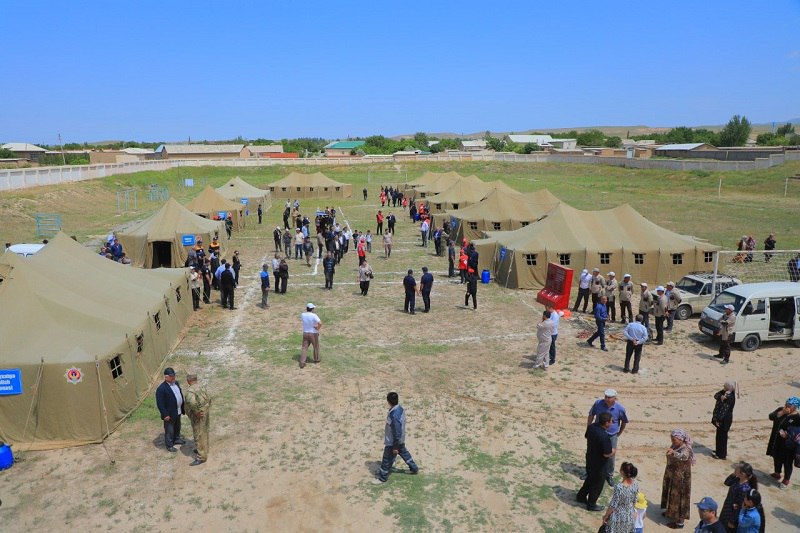Advanced technologies have transformed early warning systems, but it is the human element — education, awareness and culture of preparedness — that is the foundation of true resilience, Akiko Fujii, UNDP resident representative, writes in her op-ed on International Day for Disaster Risk Reduction.

Evacuation drills for residents of the Jush neighborhood in the Koshrabad district of Samarkand region
Japan is widely recognized for its extensive disaster preparedness efforts, particularly in managing earthquakes. The country has developed a comprehensive approach that includes strict building codes to make structures earthquake-resistant, extensive public education campaigns, and early warning systems.
Growing up in Japan, earthquake drills were a regular part of life. We learned simple but crucial steps: cover your head with a cushion, take shelter under a sturdy table, and move calmly to a safe space. These small acts of preparedness – like not sleeping near shelves or placing heavy items on them – helped us feel ready. It was common practice, especially among the older generation, to follow these rules and keep emergency bags packed, ready to grab if disaster struck.
However, my experience volunteering after the Great Hanshin Earthquake in January, 1995 (7 magnitude) revealed that impact varies in different communities. The more vulnerable and poorer get the hardest hit. Living in less protected houses, with no or little savings, many lost everything. Some neighborhoods, by contrast, were better equipped to withstand the disaster.
As climate change intensifies, one of the greatest challenges we face is ensuring the safety and resilience of communities. In Uzbekistan, rising temperatures and unpredictable weather patterns have led to an increase in natural disasters, including floods, droughts, and mudflows.
According to the Agency for Hydrometeorological Service (Uzhydromet), these events are becoming more frequent and severe, posing a growing threat to both the population and the economy. On average, in Uzbekistan natural disasters affect 1.4 million people annually and cause nearly $3 billion in damage. A severe flood could cost the economy up to 5% of GDP, with similar consequences expected from a major drought. Climate change is expected to worsen these impacts, making it critical for every resident to be prepared.
To address these challenges, the Government of Uzbekistan has made climate adaptation a national priority. In collaboration with the United Nations Development Programme, the Government of Uzbekistan has been developing a comprehensive Early Warning System (EWS) that provides timely and accurate information about potential hazards, enabling communities to take emergency measures to mitigate disaster risks. The goal is to “Substantially increase the availability of and access to multi-hazard EWS and disaster risk information and assessments to the people by 2030.”
A resident of the "Obodon" makhalla in the Kasansay district, Namangan region, with her granddaughter after participating in evacuation drills
Important to note that EWS consists of four key elements: risk knowledge, monitoring and warning services, dissemination and communication, and response capability. It means, that EWS is not only about technology. Inclusive public communication and the preparedness prompt response of every resident are essential to building truly resilient communities.
Why Inclusive Public Communication Matters
Through the use of modern communication channels – such as SMS alerts, radio broadcasts, and social media – the MES provides real-time updates to people in disaster-prone areas. However, for these messages to be effective, they must be tailored to meet the diverse needs of the population. This includes making sure that messages are accessible to all, regardless of gender, age, ability, or language.
Ineffective communication and distribution of warnings often lead to inadequate or no response at all. Historically, most failures in early warning systems have been caused by miscommunication and negligence, rather than equipment or infrastructure issues, highlighting the critical importance of clear communication.
Public communication must also focus on education and awareness. People need to understand not only that a disaster is coming but also how to respond. This requires ongoing efforts to educate the public about evacuation procedures, safety measures, and the importance of early action.
Clear, timely, and accessible communication is prioritized to ensure that everyone, including vulnerable populations, can quickly grasp what actions to take, making public communication a cornerstone of the country's disaster preparedness and resilience strategy.
The Role of Every Resident in Community Resilience
Public education is also a key part of a national strategy. Regular campaigns, community workshops, and school drills teach citizens how to respond in emergencies. These initiatives ensure people understand evacuation routes, safety procedures, and how to secure their homes against potential risks.
Community activists in the Syrdarya region sketch plans of their neighborhoods and determine evacuation routes during a training session
UNDP, MES and Uzhydromet in their joint initiative emphasize local engagement by training volunteer rescue teams, conducting community drills, and creating evacuation plans with the focus on vulnerable populations. Over the past three years, we have trained more than 850 residents from our target makhallas located in the disaster-prone areas on climate risks and disaster preparedness, while engaging over 3,000 people in evacuation drills to strengthen their preparedness for disaster risks. During these activities, communities’ activists created local settlement plans that identify hazard zones and outline evacuation routes.
We believe, that these initiatives ensure that residents are not only aware of the risks, but also capable of taking decisive action when disaster strikes.
Preparedness must address the diverse needs of everyone, recognizing vulnerabilities and tailoring plans accordingly. A gender lens is crucial, ensuring emergency kits include essential items like feminine products, for instance. Reducing poverty and inequality strengthens communities. Having a well-prepared, targeted plan for those who need it most can make all the difference.
While advanced technology has transformed early warning systems, it’s the human element – education, awareness, and culture of preparedness – that remains the foundation of true resilience. Every one of us – whether it’s you, me, or our neighbors – has a role in building a safer and more resilient Uzbekistan, especially in the face of climate change.

 Locations
Locations